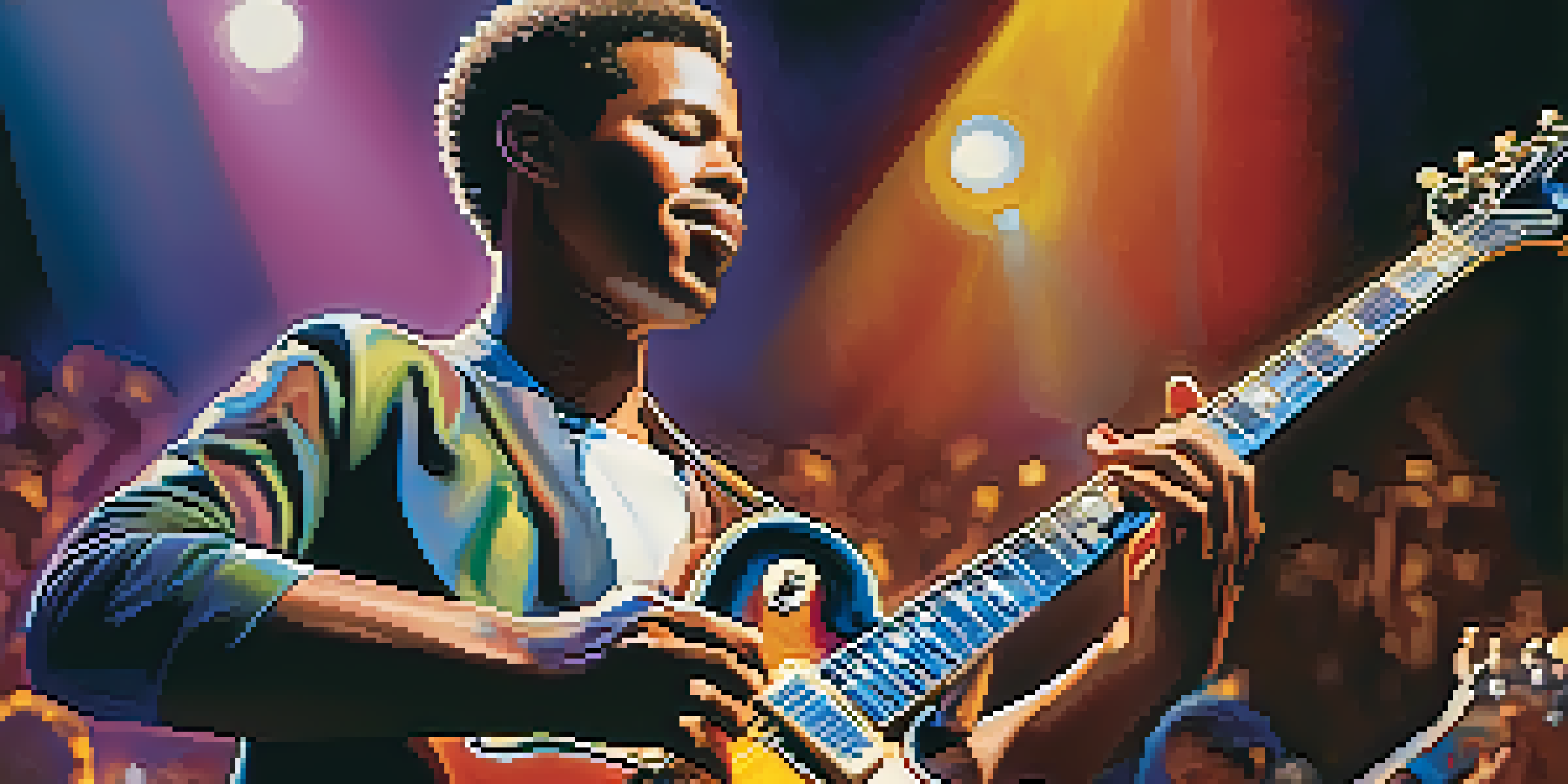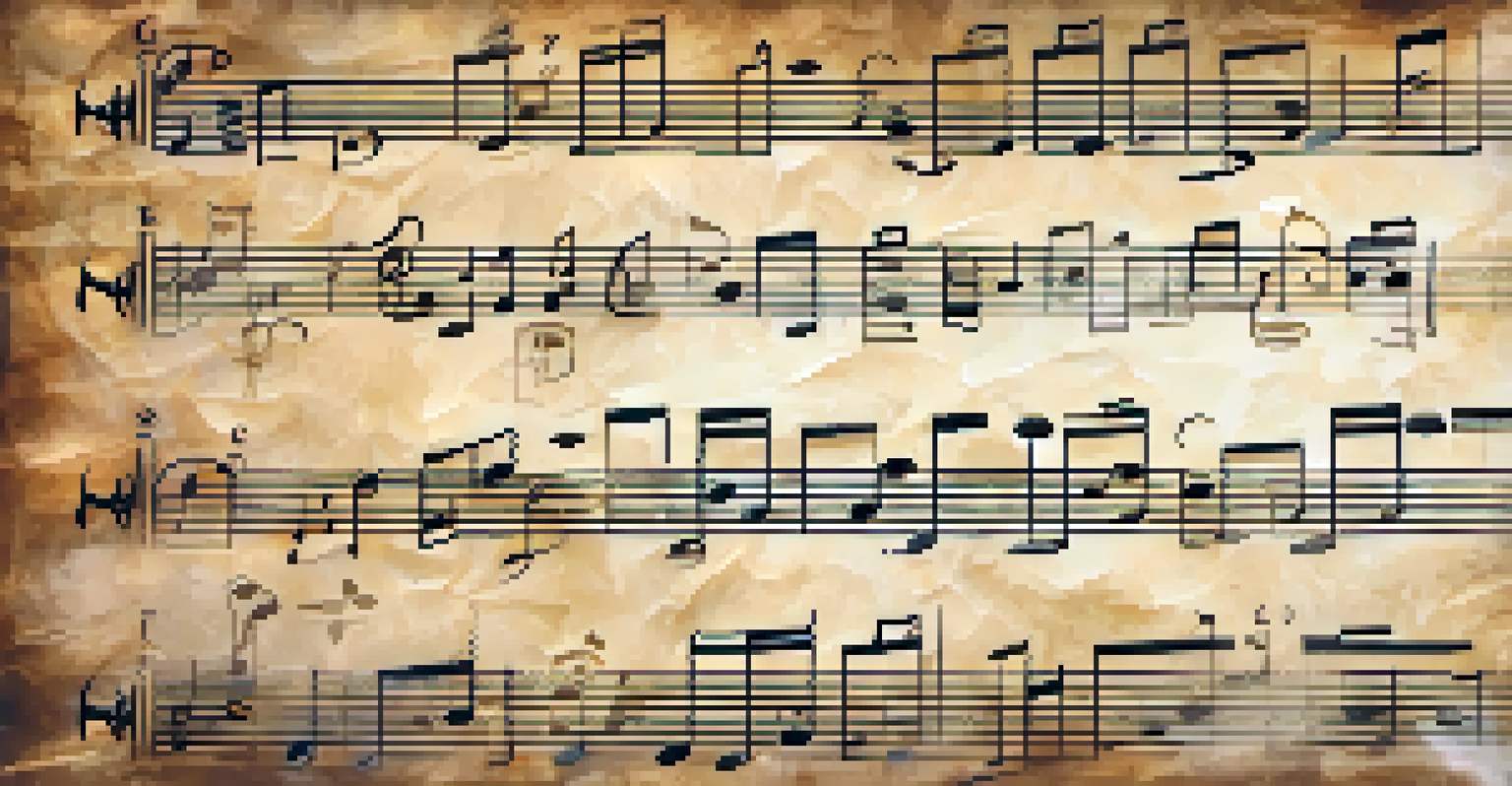Chord Progressions for Jazz Guitar Improvisation

Understanding the Basics of Jazz Chord Progressions
Before diving into specific progressions, it's essential to grasp the basics of jazz harmony. Jazz chord progressions often involve extended chords like 7ths, 9ths, and 13ths, which add richness and complexity to the music. This harmonic complexity is what makes jazz so intriguing and allows for greater improvisational freedom.
Jazz is not just a music genre; it's a way of life that allows freedom of expression and creativity.
For example, a simple Cmaj7 chord can transform the mood of a piece compared to a standard C major chord. By understanding these extended chords, you can start to see the building blocks of many jazz standards and how they can be manipulated creatively.
Ultimately, knowing these fundamentals will provide a solid foundation for both playing and improvising in the jazz genre. As you explore further, you'll discover how these elements come together in various progressions to create the unique sound of jazz.
The Classic ii-V-I Progression and Its Variations
One of the most essential chord progressions in jazz is the ii-V-I progression. This sequence—often found in countless jazz standards—consists of the second (ii), fifth (V), and first (I) chords of a scale. For example, in the key of C major, this would be Dm7-G7-Cmaj7, a progression that resolves beautifully and offers a satisfying sound.

You can enhance this progression by adding alterations, such as a flat 9 or sharp 11 to the V chord, creating tension that resolves when moving to the I chord. This tension and release is a critical part of jazz improvisation, allowing musicians to express a variety of emotions and styles.
Jazz Chords Add Depth to Music
Understanding extended chords enhances the richness and complexity of jazz harmony.
Experimenting with different voicings and extensions in the ii-V-I progression can lead to exciting variations. By incorporating these elements into your playing, you’ll not only sound more sophisticated, but you’ll also have a solid framework for improvisation.
The Importance of the I-vi-ii-V Progression
Another popular progression in jazz is the I-vi-ii-V, which creates a sense of movement and anticipation. In the key of C, this translates to Cmaj7-Am7-Dm7-G7. This progression is often used in jazz standards and provides a great opportunity for improvisation because of its circular nature.
Improvisation is the essence of jazz. It's about being spontaneous and letting the music take you where it wants to go.
The beauty of this progression lies in its ability to cycle back to the tonic chord, creating a natural flow. The transition from I to vi introduces a minor flavor, while the ii-V leads back to the I chord, offering a satisfying resolution.
As you practice improvising over this progression, try to highlight the unique qualities of each chord. By focusing on the distinct sound of each chord, you'll enrich your improvisational style and develop a deeper understanding of jazz harmony.
Exploring the Backdoor ii-V Progression
The backdoor ii-V progression is a clever way to resolve to the tonic chord using a different path. Instead of the typical ii-V-I, this progression uses a bVII7 to IV7, leading to I. In the key of C, this would look like Bb7-Eb7-Cmaj7, offering a fresh take on resolution.
This approach adds an unexpected twist, creating a sense of surprise in your playing. It’s a great tool for improvisation, as it allows you to explore different melodic ideas while maintaining a connection to the tonic.
Essential ii-V-I Progression
The ii-V-I progression is fundamental in jazz, providing a satisfying resolution and a framework for improvisation.
Incorporating backdoor ii-V progressions into your practice can enhance your versatility as a jazz guitarist. Embracing these unique pathways will broaden your improvisational vocabulary and make your performances more engaging.
Utilizing Modal Interchange in Chord Progressions
Modal interchange, or borrowing chords from parallel modes, can add depth and color to your jazz improvisation. By incorporating chords from related modes, you can create unexpected twists in your progressions, making them more dynamic. For example, borrowing a bIII or bVII from the parallel minor can provide a fresh sound.
In practice, this might mean substituting a Bbmaj7 for a Bdim in a Cmaj7 progression, adding a new texture to your improvisation. This technique not only breaks up predictability but also opens up a new palette of sounds to explore.
As you experiment with modal interchange, remember to listen closely to the emotional impact of your choices. This will help you develop your unique voice as a jazz guitarist, allowing your improvisation to stand out.
Incorporating Rhythm Changes into Your Playing
Rhythm changes, based on the chord progression of the George Gershwin classic 'I Got Rhythm', are a staple in jazz. The structure typically follows a AABA format, with the A sections featuring a I-vi-ii-V progression. This familiar structure allows for creative improvisation, as musicians can explore numerous melodic ideas.
Practicing over rhythm changes not only helps to develop your improvisational skills but also enhances your ability to navigate complex chord changes. The challenge lies in maintaining a cohesive sound while exploring different melodic lines.
Explore Modal Interchange
Incorporating modal interchange can introduce unexpected twists and broaden your improvisational palette.
As you become comfortable with rhythm changes, try adding your own twists or variations. This will not only push your creative boundaries but also deepen your understanding of jazz harmony and improvisation.
The Role of Extended Chords in Jazz Improvisation
Extended chords, such as 9ths, 11ths, and 13ths, play a significant role in jazz improvisation. These chords add complexity and richness, giving musicians more options for expression. For instance, a Cmaj9 adds a D note to the Cmaj7, creating a fuller sound that can inspire new melodic ideas.
Incorporating these extended chords can elevate your improvisation, allowing you to explore a wider range of emotions and textures. They often serve as a backdrop for improvisation, providing a lush harmonic landscape to navigate.

As you experiment with extended chords, focus on how they can transform your improvisational lines. By understanding their unique qualities, you'll be able to craft more intricate and engaging solos.